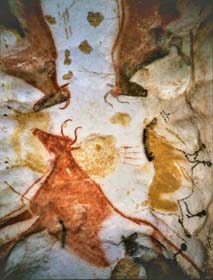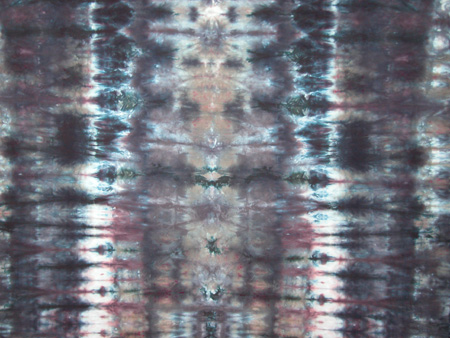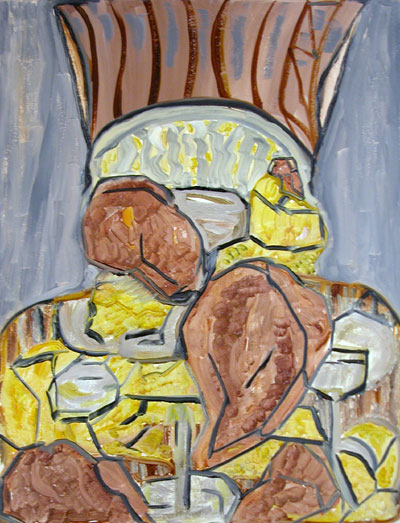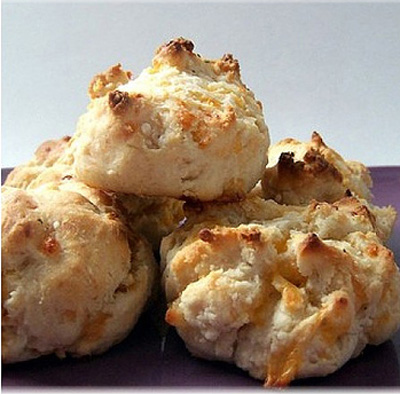Posted by June Underwood on August 31st, 2007
I’m just back from a pleine aire, oil painting workshop and it seems that my topic — to paint in the middle in the muddle or to recollect in tranquility — has arisen again on A&P. Hi Sunil…..
Obviously I’m fascinated with the immediate ambiance as much as I am with the final product. The milieu from which I just returned, however, had its problems. The big one was the lack of focus within the landscapes we were asked to paint. So the topic of the day is — how do you find your viewpoints and hold them? more… »
Posted by June Underwood on August 17th, 2007
David Lewis-Williams in The Mind in the Cave and Inside the Neolithic Mind postulates that religion has its origins in hard-wired brain functions he calls “states of altered consciousness.” Among these altered states are the hypnogogic (just prior to and awakening from sleep) as well as states induced by consciously chosen activities, for example, rhythmic dancing, meditation, and persistent highly rhythmical sound patterns. And then there are the other well-known states, whether chosen or inflicted, that alter consciousness — ingestion of psychotropic substances, intense concentration, fatigue, hunger, sensory deprivation, extreme pain, migraine, temporal lobe epilepsy, hyperventilation, electrical stimulation, near-death experiences, and schizophrenia and other pathological conditions (Inside the Neolithic Mind, page 46).
These states of consciousness, combined with homo sapiens’ ability to remember the visions that occur in such states, says Lewis-Williams, account for the rise of religion, some social organizations (primarily religious hierarchies), and the early paintings and art found in western Europe at places like the caves of Lascaux well as in the Near East around the upper reaches of the Tigris-Euphrates, Jordan, and Turkey. more… »
Posted by June Underwood on August 3rd, 2007

I was struck by Sunil’s post about his alteration/destruction of work into which he had put so much effort. In fact, I liked his revised “Palimpsest” very much, although I can see that it doesn’t resemble much of what he has shown us before this.
Because I have so many failed, partly completed, destroyed, altered, and despised pieces sitting around in boxes, baskets, photos and my memory, I thought I’d run through a taxonomy of my bad work and its place in my art-making universe. Ultimately my question is whether I’ve made adequate categories of “failure” or if there are others that could be added; in addition, I wonder if you can suss out what “runs” your failures — what, particularly if it’s not just a problem of quality, causes you to throw up your hands and ditch work.
So here are my categories. There’s work that simply fails — period, full stop. There’s work that gets altered, thus morphing into something else. There are series that come to an abrupt halt. And finally there’s work that’s put on hold.
Failed work has its own subcategories, of course, including failures to work the materials, failures of skill, failures of insight, and failures of resonances within one’s conceptual worlds. more… »
Posted by June Underwood on July 20th, 2007
I’m in a maundering mood, trying to pin down the meaning of a tiny revelation I had the other day.
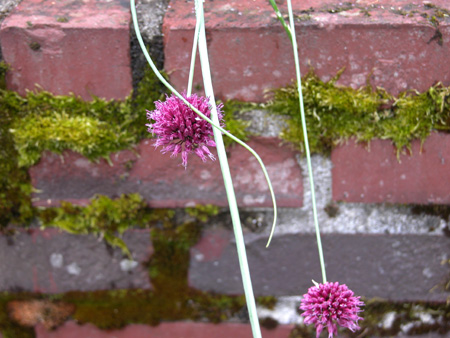
I was doing my 7 AM walk with my digital camera, getting photos of flowers, shrubbery, moss, walls, the usual panoply of residential flora on the pleasant July streets of Portland Oregon. But suddenly I found myself seeing the foliage and supports, stems and stamens, bricks and buds, as Art.
more… »
Posted by June Underwood on July 6th, 2007
In an interview for a quilting magazine recently, I was asked why I liked oil paints. I found myself speaking lovingly about the names of paints — burnt sienna, cadmium yellow, quinacridone magenta, perylene black, French ultramarine.
My response surprised (even) me. I hadn’t actually thought of the names of colors as a reason to like a specific medium. Thinking it over, however, I came to understand why I fell into praising the precisely designated oil paints. And watercolor paints. And even acrylics.
It isn’t the names, charming as I find them, so much as it is that the names signify a specific color that holds fairly true across media and brands.
To understand the hold that standardized pigments have for me, you have to know that I began my color education with textile dyes rather than pigment paints. Once you have struggled with making art with dyes, you find that using pigmented paints seems ridiculously easy.
Here are reasons why dyes are inherently difficult to control.
more… »
Posted by June Underwood on June 22nd, 2007
It’s interesting to see Sunil lamenting the lack of contemporary portrait artists as I consider my own dilemma — too many landscape artists. Or maybe just too many that follow me into drugstores and gift shops.
How do you respond to the old masters, those artists whose work stuns you and also follows you, ubiquitous, featured on postcards, tea pots, and backsides everywhere you go? This is a question I’ve been pondering.
Recently on the blog I adminster, the Ragged Cloth Cafe, one of the regulars posted a blog on Ansel Adams. My response to her comments was a bit jaded, or maybe even irritated. Another of the regular posters on the blog called me on it: “June, you do sound a bit cranky and a bit unfair to modern landscape photographers. Or is it like seeing drip painting and only being able to think of Pollack?”
As I reread what I had written I realized that indeed I was sounding more than bit cranky (and even a bit incoherent). After a few further comments I sorted out what my head was thumping around with, dissing Adams. Here’s something of what I wrote:
You may have hit on why I am currently in a state of irk-dom about Adams — it’s because I’m trying to find my own way with landscape and his images loom altogether too large in my mind. I have to wrangle and fight with him a bit (Jacob and the angel?) to make my way to my own vision.
I often find this is the case for me — at various times in doing my art, I find myself fighting my way through to my own style, arguing (if only with myself) about the too-much-with-us-giants who block my view.
I think this is yet another version of Karl’s posts here and here) “Why is making art so hard?” I had the same difficulty with the Cubists (see the two homemade oils that flank this post) with whom I spent the last 10 days harrassing and wrestling. Oddly enough, though, I don’t have the same issues with Cezanne. It may be that he is just far enough out of the old masters/coffee-cup loop to give me fresh insights rather than making me strain and struggle to see afresh.
It’s not that I blame the artists for being so outstandingly good (even I admit that that’s a bit over the top); it’s that to see afresh is such a struggle that I want to fling a paint-loaded brush onto my memory book of Adams’ photos and smear them thoroughly so I’m not seeing them while I’m working. It’s a kind of internal thrashing about, trying to break through to the other side.
more… »
Posted by June Underwood on June 8th, 2007
In a small art group that Jer and I belong to, we were given a challenge: for the next meeting, we were each to create some form of art based on “biscuits.” That meeting will be next week. I have to make some art. Using “biscuits” I came up with an anagram: “is Cubist.” I will make a Cubist-style painting, containing biscuits.
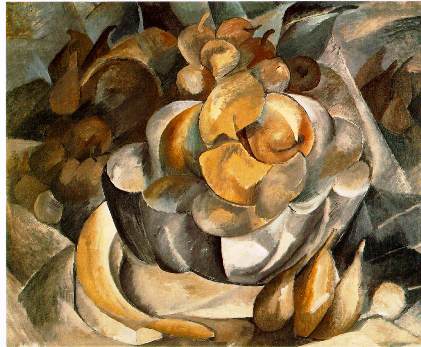
I thought the exercise would be simple. I would look at some Cubist works, get a couple books from the library and raid my bookshelves to see what others had to say, decide on motifs beyond the biscuits, and do a few sketches. Then, I would be ready to paint. more… »
